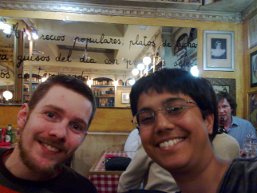Blog by Sumana Harihareswara, Changeset founder
GNOME Marketing Hackfest (Zaragoza, Spain), Day One
Hi, reader. I wrote this in 2010 and it's now more than five years old. So it may be very out of date; the world, and I, have changed a lot since I wrote it! I'm keeping this up for historical archive purposes, but the me of today may 100% disagree with what I said then. I rarely edit posts after publishing them, but if I do, I usually leave a note in italics to mark the edit and the reason. If this post is particularly offensive or breaches someone's privacy, please contact me.
Yesterday we officially started the GNOME Marketing hackfest, centering on planning the release of GNOME 3.0 on 29 September 2010. Paul Cutler started us off by talking about goals for the week. He wants us to blog about what we're doing, and to take care to recap action items and follow up after this hackfest to execute them well.
Stormy Peters noted that we have a great, diverse set of skillsets in the room. The last hackfest did a lot of groundwork and generated a lot of ideas and action items. This time, we want to get a lot of immediately useful things *made*.
 (Then we
did introductions.)
(Then we
did introductions.)
Paul recapped the November marketing hackfest, which Jason Clinton and Stormy Peters blogged at the time.
- What's GNOME 3? (more details below)
- Our marketing for GNOME 3: concentrating on existing users. We're talking to our base.
- We wrote talking points on the wiki.
- Lesson learned: make sure all our marketing assets have a blank space for downstream distributions to put their assets.
- We created FAQ text (but need art/design for it), wrote brochure text, and created a presentation template; we need to wrap all that in a GNOME Ambassador webpage.
- We need our own community to buy in to GNOME 3 and spread the word that it's useful and a great upgrade. Module maintainers, GSoC students, etc. already are spreading some word, but is it a positive message? Virality would be great, so we should make the assets rebrandable, do the videos and disseminate HOWTOs.
I asked for a reminder of the GNOME mission: accessible, free, localized. We offer free desktop (technology) to everyone. We say "technology" these days because of mobile, cellphones, and so on, but mobile is not really what we'll talk about this week. For instance, the GNOME Shell team isn't targeting mobile handsets as a platform.
So, in that light: GNOME 3. What's in it?
- GNOME Shell (less interrupty UI with clearer control of desktops, notifications, and launching apps), help (topic-based), possibly performance improvements on login time (gconf-to-dconf switch, if it makes it into the release), Evolution autoconfig (probably),
- GNOME Shell is NOT slower than old UI. It might be faster, which would be nice! And Vincent Untz (of the Release Team) says that about 98% of existing users shouldn't have hardware blockers to switching. As Jason Clinton notes, Red Hat is working all-out on fixing the possible software (driver) blockers so we basically assume that'll be fixed in time.
- What about GNOME Activity Journal? Shell & GAJ aren't really integrated, teams might be working at cross purposes. GAJ team has submitted a module. We have a meeting next weekend for the release team to decide what to do. GNOME wants something consistent. Right now, GS & GAJ seem too different from each other.
- Accessibility improvements. The GNOME 2 accessibility framework was GNOME-specific, but GNOME 3 a11y is cross-desktop...KDE, small devices, Qt, Nokia, etc. can and will use it. The new stack is useful for a11y, desktop testing, and other purposes. For example, Stormy told us that there's an HFOSS tool that turns audio alarms into visual alarms. This is great for the hearing-impaired -- and if you're in a meeting! Remember the curb cuts principle; accessibility improvements help everyone.
A few notes about the a11y changes: speech synthesis will probably be ok. The first iteration of the onscreen keyboard may functionally be a step back. The current one is basically unused, since it's not very good. (For an example of low distribution uptake: Ubuntu currently uses a different one they coded, which is simpler but has different bugs.) The new one may not be ready by September.
- A lot of housecleaning (paying off technical debt) to make it far easier to develop and maintain GNOME apps and core going forward
- Tomboy online. By the way, Tomboy is big on other OSes! Andreas Nilsson shared his experience: he went to a neighbor's house and installed a couple of GNOME apps on their Windows machine, including Tomboy. The next week, they'd switched entirely to GNOME on Linux!
- Streamlined appearance: less chrome on some apps, symbolic icons in tray....clean & lean experience/appearance
(One issue to address is GNOME panel applets. Everyone Vincent has talked with uses about three applets (out of about 20 available ones), but everyone uses a different set of three. So we need to work with the community to find a way to bridge that experience gap for GNOME 3.0.)
So here are some notes towards our marketing message for GNOME 3:
- GNOME 3 is about UI. Performance work, GNOME Shell, help, the streamlined appearance, and GAJ all make the user experience better and more responsive.
- Accessibility. We are the best free desktop in terms of accessibility,
- We want to talk more about the ecosystem and applications, especially since we don't generally spotlight that enough. People don't realize that GNOME is a suite of apps as well as the core desktop. Paul blogged to ask for names of applications that are adding new features for GNOME 3.0. What apps and desktop components/tools are adding benefits? True, the platform/components story targets developers rather than users, and we're primarily concentrating on the user message in this hackfest and in the GNOME 3.0 marketing overall, but we do want to invest some in marketing to developers, because they'll evangelize.
- GNOME 3.0 is iterative. We continue to evolve every 6 months. This is the beginning of GNOME 3; we're starting a new cycle. For example, GNOME 3.0 lays a foundation to do better geolocation, desktop testing, and integration with social networking sites. We should specify this in our message to developers: "We added foo so we can add bar next year" -- and to users: "We added foo so you can do bar." The post-September roadmap will be clearer after GUADEC, but even now we can start on "Come to GNOME 3 and this is what we'll take you to..."
(As we talked about highlighting GNOME apps, we reminded ourselves of long-term marketing ideas, less for GNOME 3.0 than for future marketing work: a cross-platform App Store that senses your OS and shows you free GNOME apps to download. Another: tie together About boxes on apps to Friends of GNOME. Make it easier for users to realize that they can give back via cash donations. Store what app inspired them to give cash, and feed that app's About box with specific users' names, once donations pass a certain amount.)
In a sense, our list of audiences (in order of priority) is:
- current users of GNOME 2.x
- GNOME developers
- the accessibility community
- distributions (such as OpenSUSE, Fedora, Ubuntu, and Mandriva)
And a home for our GNOME 3 marketing message: gnome3.org. This will be a small, product-specific site that goes away (that is, redirects/moves to gnome.org) six months after the GNOME 3 launch (approximately). We're building the sitemap for it this week.
By the way, Paul and Vincent are going to coordinate on the improvement of the gnome.org website; evidently there's a relaunch in the works! Plone is involved somehow.
 Stormy then led us through deciding what we'll do this week in the hackfest. HIGHEST priority:
Stormy then led us through deciding what we'll do this week in the hackfest. HIGHEST priority:
- GNOME 3 website sitemap
- GNOME 3 roadmap/launchplan calendar
- Talking points: GNOME 3 message, making apps/components story, localizing tagline
ALSO:
- Pilot demo video (per Jason's script) and a template for future videos
- Developing GNOME Ambassadors materials and putting together a coherent suite of those resources
- Distro messaging
- Thoughtleadership around a11y & usability, and outreach to find/make/convert those thought leaders and GNOME 3 evangelists
And we roughly scheduled it as follows:
- Tuesday morning: talking points and launch roadmap
- Tuesday afternoon: further work on launch roadmap, and then ambassadors, website, & video template discussion starts
- Wednesday morning: lots of work on website & ambassadors, maybe video work
- Wed. afternoon: can continue videos & thought leadership
- Thursday: buffer to cover what we didn't work on earlier in the week; film video
So Tuesday morning we worked on those talking points (soon to come to the wiki) and the launch roadmap (ditto).
After lunch, we finished our rough roadmap, then spoke about some various other topics before diving into website and Ambassador work. Bharat Kapoor suggested that we think about SMS fundraising at conferences, and about corporate sponsorship/involvement with Ambassadors.
As a group, we roughed out some ideas for what GNOME Ambassadors is (materials/collateral that anyone can use to evangelize GNOME) and for the website. One question re: the website: will it be a Plone site? There are some dependencies here regarding the existing website infrastructure and a delayed reboot; Ryan and I will talk about getting a project manager to do the CMS relaunch. In any case, we're going to go forward assuming that it's a Plone site that we can localize, and that the marketing team will own the responsibility for coding it and getting it up.
Then we broke into smaller groups to get more specific on the website and Ambassadors (to get wikified when we have time -- this week, I hope!) and developed some TODOs for the work session on Wednesday.
We also met local representatives who told us about the free software scene in Zaragoza and in Spain overall. We're so grateful to them for their hospitality and support!
(And throughout the day, we captured some other TODOs that we'll do after the hackfest...)
